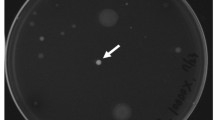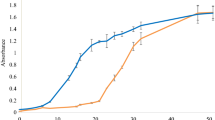Abstract
Brettanomyces/Dekkera bruxellensis is a cause of major concern for the winemaking industry worldwide. If a slight presence of this spoilage yeast in red wine adds a Brett character, a strong contamination has irreversible and detrimental effects on the organoleptic qualities due to the production of volatile phenols such as 4-ethylphenol. Time is a key factor in the treatment of B. bruxellensis contaminations. Nowadays, the diagnostic and quantification resources available are time consuming and too expensive, making them either inadequate or inaccessible to most of the winemakers. This study was focused on a new, easy to use, inexpensive method that could allow winemakers to directly detect B. bruxellensis contamination in red wine at an early stage, hence, reducing wine spoilage. In this work, the ability of Pseudomonas putida 4-ethylphenol methylene hydroxylase was tested in order to catabolize the 4-ethylphenol and to elaborate an enzymatic assay with the purpose of detecting early contaminations by B. bruxellensis in red wine. We have developed a colorimetric enzymatic assay, based on the redox state of the 4-ethylphenol methylene hydroxylase co-factor, cytochrome C, that can detect and quantify low concentrations of 4-ethylphenol. The range of concentrations detected is well below the level detectable by the human nose. Combined to an enrichment step, this method allows the detection of B. bruxellensis at an initial concentration of less than 10 cells per ml.






Similar content being viewed by others
References
Woolfit M, Rozpędowska E, Piškur J, Wolfe KH (2007) Genome survey sequencing of the wine spoilage yeast Dekkera (Brettanomyces) bruxellensis. Eukaryot Cell 6:721–733
Renouf V, Lonvaud-Funel A (2007) Development of an enrichment medium to detect Dekkera/Brettanomyces bruxellensis, a spoilage wine yeast, on the surface of grape berries. Microbiol Res 162:154–167
Garijo P, González-Arenzana L, López-Alfaro I, Garde-Cerdán T, López R, Santamaría P, Gutiérrez AR (2015) Analysis of grapes and the first stages of the vinification process in wine contamination with Brettanomyces bruxellensis. Eur Food Res Technol 240(3):525–532
Chatonnet P, Dubourdieu D, Boidron JN (1995) The influence of Brettanomyces/Dekkera sp. yeasts and lactic acid bacteria on the ethylphenol content of red wines. Am J Enol Vitic 46:463–468
Romano A, Perello MC, De Revel G, Lonvaud-Funel A (2008) Growth and volatile compound production by Brettanomyces/Dekkera bruxellensis in red wine. J Appl Microbiol 104:1577–1585
Peynaud E, Domercq S (1956) Sur les brettanomyces isolés de raisins et de vins. Arch Mikrobiol 24:266–280
Suárez R, Suárez-Lepe JA, Morata A, Calderón F (2007) The production of ethylphenols in wine by yeasts of the genera Brettanomyces and Dekkera: a review. Food Chem 102:10–21
Edlin DAN, Narbad A, Dickinson JR, Lloyd D (1995) The biotransformation of simple phenolic compounds by Brettanomyces anomalus. FEMS Microbiol Lett 125:311–315
Dias L, Dias S, Sancho T, Stender H, Querol A, Malfeito-Ferreira M, Loureiro V (2003) Identification of yeasts isolated from wine-related environments and capable of producing 4-ethylphenol. Food Microbiol 20:567–574
Sáez J, Lopes C, Kirs V, Sangorrín M (2010) Enhanced volatile phenols in wine fermented with Saccharomyces cerevisiae and spoiled with Pichia guilliermondii and Dekkera bruxellensis. Lett Appl Microbiol 51:170–176
Renouf V, Falcou M, Miot-Sertier C, Perello MC, De Revel G, Lonvaud-Funel A (2006) Interactions between Brettanomyces bruxellensis and other yeast species during the initial stages of winemaking. J Appl Microbiol 100:1208–1219
Fugelsang KC, Edwards CG (2007) Wine microbiology: practical applications and procedures. Springer, Berlin
Benito S, Palomero F, Morata A, Calderón F, Suárez-Lepe JA (2009) Factors affecting the hydroxycinnamate decarboxylase/vinylphenol reductase activity of dekkera/brettanomyces: application for dekkera/brettanomyces control in red wine making. J Food Sci 74:15–22
Costa A, Barata A, Malfeito-Ferreira M, Loureiro V (2008) Evaluation of the inhibitory effect of dimethyl dicarbonate (DMDC) against wine microorganisms. Food Microbiol 25:422–427
Morata A, Vejarano R, Ridolfi G, Benito S, Palomero F, Uthurry C, Tesfaye W, González C, Suárez-Lepe JA (2013) Reduction of 4-ethylphenol production in red wines using HCDC+ yeasts and cinnamyl esterases. Enzyme Microb Technol 52:99–104
Setati Mehlomakulu ME, Divol B (2015) Non-Saccharomyces killer toxins: possible biocontrol agents against Brettanomyces in wine? S Afr J Enol Vitic 36(1):94–104
Kheir J, Salameh D, Strehaiano P, Brandam C, Lteif R (2013) Impact of volatile phenols and their precursors on wine quality and control measures of Brettanomyces/Dekkera yeasts. Eur Food Res Technol 237(5):655–671
Pradelles R, Alexandre H, Ortiz-Julien A, Chassagne D (2008) Effects of yeast cell-wall characteristics on 4-ethylphenol sorption capacity in model wine. J Agric Food Chem 56:11854–11861
Ugarte P, Agosin E, Bordeu E, Villalobos JI (2005) Reduction of 4-ethylphenol and 4-ethylguaiacol concentration in red wines using reverse osmosis and adsorption. Am J Enol Vitic 56:30–36
Vasserot Y, Caillet S, Maujean A (1997) Study of anthocyanin adsorption by yeast lees. Effect of some physicochemical parameters. Am J Enol Vitic 48:433–437
Rodrigues N, Gonçalves G, Pereira-da-Silva S, Malfeito-Ferreira M, Loureiro V (2001) Development and use of a new medium to detect yeasts of the genera Dekkera/Brettanomyces. J Appl Microbiol 90:588–599
Divol B, Lonvaud-Funel A (2005) Evidence for viable but nonculturable yeasts in botrytis-affected wine. J Appl Microbiol 99:85–93
Millet V, Lonvaud-Funel A (2000) The viable but non-culturable state of wine micro-organisms during storage. Lett Appl Microbiol 30:136–141
Zott K, Claisse O, Lucas P, Coulon J, Lonvaud-Funel A, Masneuf-Pomarede I (2010) Characterization of the yeast ecosystem in grape must and wine using real-time PCR. Food Microbiol 27:559–567
Willenburg E, Divol B (2012) Quantitative PCR: an appropriate tool to detect viable but not culturable Brettanomyces bruxellensis in wine. Int J Food Microbiol 160:131–136
Vendrame M, Manzano M, Comi G, Bertrand J, Iacumin L (2014) Use of propidium monoazide for the enumeration of viable Brettanomyces bruxellensis in wine and beer by quantitative PCR. Food Microbiol 42:196–204
Stender H, Kurtzman C, Hyldig-Nielsen JJ, Sørensen D, Broomer A, Oliveira K, Perry-O’Keefe H, Sage A, Young B, Coull J (2001) Identification of Dekkera bruxellensis (Brettanomyces) from wine by fluorescence in situ hybridization using peptide nucleic acid probes. Appl Environ Microbiol 67:938–941
Hixson JL, Sleep NR, Capone DL, Elsey GM, Curtin CD, Sefton MA, Taylor DK (2012) Hydroxycinnamic acid ethyl esters as precursors to ethylphenols in wine. J Agric Food Chem 60:2293–2298
Joseph C, Albino E, Ebeler S, Bisson L (2015) Brettanomyces bruxellensis aroma active compounds determined by SPME GC-MS Olfactory analysis. Am J Enol Vitic. doi:10.5344/ajev.2015.14073
Nikfardjam MP, May B, Tschiersch C (2009) 4-ethylphenol and 4-ethylguaiacol contents in bottled wines from the German “Württemberg” region. Eur Food Res Technol 230:333–341
Oelofse A (2008) Investigating the role of Brettanomyces and Dekkera during winemaking. Ph.D. thesis, Stellenbosch University, South Africa
Reeve C, Carver M, Hopper D (1989) The purification and characterization of 4-ethylphenol methylenehydroxylase, a flavocytochrome from Pseudomonas putida JD1. Biochem J 263:431–437
Reeve C, Carver M, Hopper D (1990) Stereochemical aspects of the oxidation of 4-ethylphenol by the bacterial enzyme 4-ethylphenol methylenehydroxylase. Biochem J 269:815–819
Nisiotou A, Gibson G (2005) Isolation of culturable yeasts from market wines and evaluation of the 5.8S-ITS rDNA sequence analysis for identification purposes. Lett Appl Microbiol 41:454–463
Kheir J, Kallassy M, Salameh D, Lteif R, Brandam C, Strehaiano P (2014) Brettanomyces yeasts isolated from lebanese wines showing difference in their molecular pattern. Eur Sci J 10(9):434–448
Botha J (2010) Sensory, chemical and consumer analysis of Brettanomyces spoilage in South African wines. Ph.D. thesis, Stellenbosch University, South Africa
ACS (1980) Guidelines for data acquisition and data quality evaluation in environmental chemistry. Anal Chem 52(14):2242–2249
McIntire W, Hopper DJ, Singer TP (1985) p-Cresol methylhydroxylase. Assay and general properties. Biochem J 228:325–335
Medawar W, Strehaiano P, Délia ML (2003) Yeast growth: lag phase modelling in alcoholic media. Food Microbiol 20:527–532
Uscanga MGA, Delia ML, Strehaiano P (2000) Nutritional requirements of Brettanomyces bruxellensis: growth and physiology in batch and chemostat cultures. Can J Microbiol 46:1046–1050
Couto JA, Neves F, Campos F, Hogg T (2005) Thermal inactivation of the wine spoilage yeasts Dekkera/Brettanomyces. Int J Food Microbiol 104:337–344
Renouf V, Claisse O, Miot-Sertier C, Perello MC, De Revel G, Lonvaud-Funel A (2006) Study of the microbial ecosystem present on the barrels surface used during the winemaking. Sci Aliments 56:26–36
Couto JA, Barbosa A, Hogg T (2005) A simple cultural method for the presumptive detection of the yeasts Brettanomyces/Dekkera in wines. Lett Appl Microbiol 41:505–510
Jiménez-Moreno N, Ancín-Azpilicueta C (2009) Sorption of volatile phenols by yeast cell walls. Int J Wine Res 1:11–18
Morata A, González C, Suárez-Lepe JA (2007) Formation of vinylphenolic pyranoanthocyanins by selected yeasts fermenting red grape musts supplemented with hydroxycinnamic acids. Int J Food Microbiol 116:144–152
Phister TG, Mills DA (2003) Real-time PCR assay for detection and enumeration of Dekkera bruxellensis in wine. Appl Environ Microbiol 69:7430–7434
Rayne S, Eggers N (2007) 4-Ethylphenol and 4-ethylguaiacol in wines from the Okanagan Valley, and the Brettanomyces/Dekkera connection. Aust NZ Grapegrow Winemak 516:52–59
Santos A, Mauro MS, Bravo E, Marquina D (2009) PMKT2, a new killer toxin from Pichia membranifaciens, and its promising biotechnological properties for control of the spoilage yeast Brettanomyces bruxellensis. Microbiology 155:624–634
Acknowledgements
We would like to thank Dr. David HOPPER form the University of Aberystwyth (Wales UK) for the purified 4-EPMH and his precious knowledge and advice.
Author information
Authors and Affiliations
Corresponding author
Ethics declarations
Conflict of interest
None.
Compliance with ethics requirements
This article does not contain any studies with human or animal subjects.
Additional information
Hélène Daniels-Treffandier and Christine Campbell have been contributed equally to this work
Rights and permissions
About this article
Cite this article
Daniels-Treffandier, H., Campbell, C., Kheir, J. et al. A new method for the detection of early contamination of red wine by Brettanomyces bruxellensis using Pseudomonas putida 4-ethylphenol methylene hydroxylase (4-EPMH). Eur Food Res Technol 243, 1117–1125 (2017). https://doi.org/10.1007/s00217-016-2822-x
Received:
Revised:
Accepted:
Published:
Issue Date:
DOI: https://doi.org/10.1007/s00217-016-2822-x




